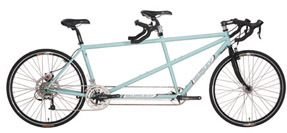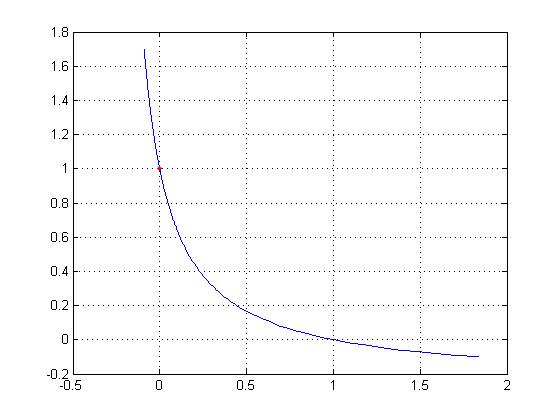

"At a soirée of the Royal Society conducted by Hill in 1952 two
subjects mounted a specially built tandem stationary bicycle. While one subject
pedaled the other subject resisted him through directly coupled pedals. At a
speed of 35 revolutions per minute, the subject pedaling forwards used 3.7 times
as much oxygen as the one pedaling backwards. It was demonstrated that a small
woman, pedaling backwards, could rapidly exhaust a large man pedaling forwards
against her resistance. Since oxygen consumption and heat production are closely
tied, the muscles of the woman were presumably generating far less heat, even
though the coupling of the pedals guarantees that the forces and displacements
experienced by the woman's feet were the same as those for the man's."
Thomas A. McMahon, from chapter 2 of Muscles, Reflexes and Locomotion, Princeton
Univ Press (1984).
Background:
The lecture notes tell you about Hill's equation for muscle
velocity-tension
![]()
with the figure below from McMahon's Muscles Reflexes and Locomotion

note the greater tension/fiber for negative velocity. The graph has been normalized

where we use  in the Matlab code described below, and you have control of constant k.
in the Matlab code described below, and you have control of constant k.
Note that α and β have the units of tension and velocity, respectively.
Muscle details:
1. Recruitment. To increase
tension (or velocity of contraction) muscle fibers are recruited, from the weakest
cells with the most endurance up to the strongest fibers, which are most easily
fatigued. Yes is it true that individual fibers can be stimulated at increasing
rates by their motoneuron axons, up to tetanus tension, but once one fiber is
pulling to the max, another fiber is recruited as necessary. In the simulation
below we have it that the "strong biker" has 100 fibers involved in
pedaling, with the maximum tension of the fibers from 1 to 100 force units.
In exercising the simulation (Tandem04.m) you choose the number of "weak
biker" fibers, an integer less than 100.
2. Velocity-dependent tension. Hill's equation shows the hyperbolic relationship
between muscle velocity and muscle tension. Note that when an active muscle is pulled
by an external load in the opposite direction of its intended contraction the muscle
is "doing a negative" (as weightlifters say) and its velocity is less
than zero. The tension per fiber is much greater in muscle fibers doing negatives
than tension in a fiber going the same speed in the opposite (positive) direction.
3. Muscle fatigue. The
FG (fast glycolytic) muscle fibers (white meat) that can exert the greatest maximum
tension are the most easily fatigued. In
Tandem04.m we model the fatigue as a first-order time constant that increases in
duration as the maximum tension per fiber decreases.
Requirements:
(1) On each of the computers in the lab, in the Work folder of Matlab, is
a folder Tandem that has a read-only file Tandem04.m function and
its subroutines TanFly04, FatigueCalc.m and recruit_fiber.m. The call
is
Tandem04(Wcnt, frce_thet, del_frce0, vmax, drg, fatigue_fac, k)
where the input arguments are
Wcnt: the number of weak muscle fibers;
frce_thet: the threshold force (torque) the strong biker must
meet in the recruitment function;
del_frce0: the approx difference between strong and weak muscle
torque used by the matlab ODE solver;
vmax: the zero-force velocity derived from Hill's equation:
drg: the drag term from the model for the bicycle load;
fatigue_fac: increases time constant of fatigue onset:
if less than 1.00 (but greater than 0) it means the rate of fatigue is increased;
k: the term noted above, from Hill's formula for normalizing velocity
or tension.
Tandem04.m
is linked to colored notations for its various sections.
If you open Matlab and type at
the command window
>> Tandem04(94, 2400, 90, 900, 14, 1.00, 0.2)
you will be asking for 94 weak fibers, with a pedal tension of 2400 units, a strong-weak
force difference of 90 units, a vmax of 900 velocity units, a mechanical drag or
friction of 14 units, a fatigue factor of 1.00 and constant k = 0.2 for Hill's equation
normalization. When you run Tandem04.m with those conditions you will see that the
strong muscle fatigues in 35 seconds, and a final fiber number vs tension plot looks
like:
Your challenge: by adjusting the simulation parameters available to you (except for pedal tension), arrange that the "strong" biker fatigues at a number of seconds to be given by JD or TA. For example: 45 seconds. play around with the fatigue and other factors and become comfortable with their effects on time when the strong biker is stopped by the weak biker.
(2) Forward pedaling vs
weak resistance on the tandem bike.
Inspect the stationary
tandem bike. Note that the gear ratios for the two sets of chains connecting
pedals to the rear flywheel are the same. Notice the mechanisms for tightening
the chains.
Note:
The Machine Shop modified a 50 year-old Schwinn tandem bicycle formerly owned
by Profs Blume and Bower.
2007: The tandem bike has fallen into disrepair: For 2007 etc skip to section (3) below.
(3) PART 3 MUST BE ADMINISTERED BY THE PROFESSOR, WHO WILL THEN SIGN OFF YOUR LAB.
We have
not yet outfitted the tandem bike or biker with sensors. Answer one of the following
questions, [selected by JD] in the following way: in your IP folder,
in a Word file:
i: find a specific sensor
for the question, and reference with a website and particular part number, and
price.
ii: describe how the specificed sensor output could reach a nearby 6024E
DAQ card in a computer.
iii. draw out or describe how the parts would be mounted on or near the
stationary tandem in the lab.
Money is no object here. You can specify the most exotic parts you like. Surgery is not prohibited either: see below.
You
are also allowed to modify the bike itself in your design...
a. How could you monitor the rotation speed of the bike pedals? The cycles/second
speed may be rather slow so you cannot just monitor when one of the pedals passes
by once or twice per cycle.
b. How could you monitor the bending moment in the arms of the pedals during
rotation? To avoid symantic difficulties, let's say you will want to measure
the strain in one of the arms, and have the measurement come off the arm. Are
there optical ways this can be done? Translate strain(s) to bending moment.
c. How could the oxygen use of a biker be sensed? Look up what a spirometer
does...you may have seen O2-CO2 sensing in Bio 80. We will want to know how
the sensor will be mounted, near the "rider".
d. How could the temperature of the quadriceps muscle be monitored? Let yourself
imagine that a rider might agree to a modest surgical implant... Keep in mind
the leg is moving...
e. How could nerve and muscle activity of the quad be monitored? Again, suppose
a subject agreed to a modest surgical--electrode implant...
What we are looking for here is about a half hour of effort online or otherwise, resulting in a "prototype" design to be shown; the result of the prototype may be feedback from the Prof that may take another half hour to implement for a final answer...
Possible FTQ's: Will the time for fatigue of the strong biker in the
simulation increase, decrease or stay the same, given a change to a parameter
selected by JD? What other muscles, besides quadriceps, participate in pedaling
a bicycle? See
http://orgs.jmu.edu/strength/KIN_425/kin_425_muscles_quadriceps.htm
otherwise the modification of design for part 3 may stand in for your FTQ here...
mathematical FTQ: What (nonlinear first-order) differential equation can account for the hyperbolic form of the velocity-force curve? Reading: pages 11-16, 30-35, from T. A. McMahon, Muscles, Reflexes and Locomotion.